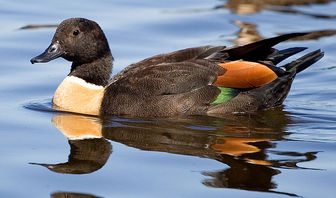Australian Shelduck
This is a bird which breeds in southern Australia and Tasmania. In the southern winter, many birds move further north than the breeding range. As with other shelducks, this species has favoured moulting grounds, such as Lake George, NSW, where sizeable concentrations occur.

Original source: Transferred from en.wikipedia; Transfer was stated to be made by User:OhanaUnited.(Original text : self-made by Martin Pot (martybugs))
Author: Original uploader was Martybugs at en.wikipedia(Original text : Martin Pot (martybugs))Permission(Reusing this file)CC-BY-3.0; Released under the GNU Free Documentation License.
Permission: GNU Free Documentation License
The Australian Shelduck is classified as Least Concern. Does not qualify for a more at risk category. Widespread and abundant taxa are included in this category.
The Australian Shelduck, Tadorna tadornoides, is a shelduck, a group of large goose-like birds which are part of the bird family Anatidae, which also includes the swans, geese and ducks. The Anatidae article should be referred to for an overview of this group of birds. This is a bird which breeds in southern Australia and Tasmania. In the southern winter, many birds move further north than the breeding range. More
Unlike other Australian ducks, the Australian Shelduck often flies in long lines or in a 'V' formation. Alternative Name/s Chestnut-breasted Shelduck, Mountain Duck and Sheldrake Identification The Australian Shelduck is a large, brightly coloured duck with a small head and bill. The male head and neck are black, tinged green, with a white neck ring and occasionally a white ring around the base of the bill. More
The Australian Shelduck is a large dark plumaged duck weighing from 1.3 to 1.5 kg, and standing 55 to 73 cm tall. Males are noticeably larger than females. Their heads, backs, bellies, and tails are blackish with green metallic highlights. There is a narrow white neck band separating the black head from the brown breast. The female's breast feathers are a rich chestnut, the male's are a paler cinnamon. More
Australian Shelducks in flight - Diet / Feeding: This duck feeds off of larvae and pupae usually found under rocks, aquatic animals, plant material, seeds, small fish, snails, and crabs. Feeding Ducks ... More
Unlike other Australian ducks, the Australian Shelduck often flies in long lines or in a 'V' formation. Facts and figures Research Species: No Minimum size: 56 cm Maximum size: 72 cm Average size: 64 cm Average weight: 1500 g Breeding season: July to December Clutch size: Ten to fourteen. More
The Australian shelduck is not a popular game bird so it has not been significantly over-hunted. What little hunting there is stems from their habit of grazing in agricultural fields, causing damage to crops. Scientists believe their populations may have grown in recent years due to the increase of irrigation in agriculture and the construction of new water impoundments, which both provide more food and more habitat for this specific species. More
A pair of Australian Shelducks, male in the front These pretty, medium-sized ducks do well in collections and may be kept in groups or with other species. They do require both greens and extra animal food (e.g., worms, minced meat) in their diet. Ground nests are preferred, in hollow trees or burrows. The female has a white ring around her eye. They need protection from extreme cold in winter. More
This Australian shelduck pairs for life and nests in the holes of dead or dying trees. In areas without trees, rabbit holes in the ground are used as nesting sites. Australian Shelduck Drake Australian Shelduck Hen Cape Shelduck: South African shelducks with a notoriously bad temper, very similar to the ruddy shelducks which it is sometimes thought to be merely a subspecies of. More
Australian Shelduck Taxidermy Photo Reference CDAvailable at external website: alaskanorthtaxidermy for $14. More
Australian Shelduck, Mountain Duck Common Names in French: Tadorne D'australie Common Names in German: Halsbandkasarka Taxonomy - * Kingdom: Animalia () - animals * Phylum: Chordata () - Chordates * Class: Aves () - Birds More
The Australian Shelduck can live to about 15 years old, it's diet includes insects, seeds, and short grasses. Shelducks also search in shallow waters for aquatic invertebrates and submerged vegetation. Before pairing up to mate the birds form large flocks of thousands of birds in a prime feeding or moulting location. More

Original source: Arthur Chapman
Author: Arthur Chapman
Permission: Some rights reserved
Family : Anatidae
Genus : Tadorna
Species : tadornoides
Authority : Jardine & Selby, 1828
